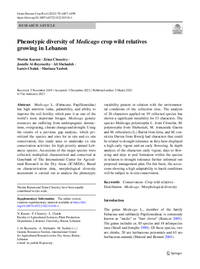Phenotypic diversity of Medicago crop wild relatives growing in Lebanon

Authors:
Medicago L. (Fabaceae; Papillionoidae) has high nutritive value, palatability, and ability to improve the soil fertility which puts it as one of the world’s most important forages. Medicago genetic resources are suffering from anthropogenic destructions, overgrazing, climate change and drought. Using the results of a previous gap analysis, which prioritized the species and sites for in situ and ex situ conservation, this study aims to undertake ex situ conservation activities for high priority annual Lebanese species. Accessions of the target species were collected, multiplied, characterized and conserved at Genebank of The International Center for Agricultural Research in the Dry Areas (ICARDA). Based on characterization data, morphological diversity assessment is carried out to analyse the phenotypic variability pattern in relation with the environmental conditions of the collection sites. The analysis of 26 characters applied on 19 collected species has shown a significant variability for 13 characters. The species Medicago polymorpha L. from Chwaifat, M. polymorpha from Shebenieh, M. truncatula Gaertn and M. orbicularis (L.) Bartal from Jeita, and M. constricta Durieu from Bwerij had characters that could be related to drought tolerance as they have displayed a high early vigour and an early flowering. In depth analysis of the characters early vigour, days to flowering and days to pod formation within the species in relation to drought tolerance further informed our proposed management plan. On this basis, the accessions showing a high adaptability to harsh conditions will be subject to in situ conservation.
